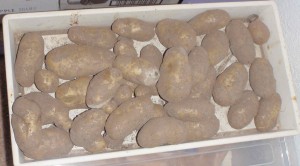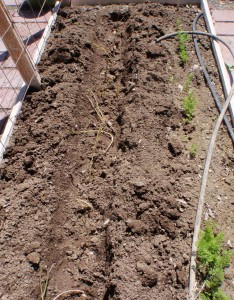I saved some of my own garden potatoes from last fall for seed this year. Unfortunately, I didn’t label them when I put them in my basement pantry. I think they are Russet Burbanks, but the only thing I’m positive about is that they aren’t red potatoes. To top it all off, I was late in getting them planted and they grew into a tangle of hopeful shoots in their cool, dim quarters. They also got pretty wrinkled, but at least they weren’t crunchy. But they are my potatoes and I wanted to plant them anyway!


Ideally, potatoes should be planted earlier in the spring, but not too soon. They can handle a light frost, but not real freezing. It’s good to see eyes just budding out and showing signs of life on seed potatoes, but I didn’t know if 1 -2 foot long eyes would hold up to planting and the shock of being buried. It was a risk to donate garden space to test it. Besides, with all the yard prep for the upcoming wedding reception, it was unlikely that I would get to the garden nursery to buy replacements. Maybe the experiment would make me a better overall potato farmer, one who knows how to manage things under less than ideal circumstances?

I dug the normal 4 inch deep trench and set all the potatoes in it with their long eyes facing up. I chose the best combinations of larger potato with thicker shoots. I also looked for potatoes that still had the most moisture in them. At this depth, the “long eyes” would have been sticking several inches above the soil after filling the trench. This would subject the stems to light and temperatures they weren’t prepared for. Fried potato eyes. There were leave buds starting to grow along the whole eye/stem things, but I decided covering those with dirt was the better option. Too much shock from heat might kill or severely stunt them, but they might have a chance in the cool dirt.
I criss-crossed the long growing eyes all along the trench. I laid them sideways, adding soil as necessary, until just the tips were at the surface of the soil and the trench was filled. When I checked on them in the next couple of days, those tips looked a little stressed, but I was still hopeful that the potatoes under ground had enough “juice” in them to support growth.



Sure enough, a few days later (after I got out of the wedding reception time warp, anyway), the whole row was bursting with potato leaves. It appears to have a leaf point from multiple sites along each long-eyed stem. Instead of the one bunch of leaves from each potato that I was used to seeing, my row looks like I gave it some magic fertilizer.
Of course, the final test will be how many potatoes I harvest. This will have to be a judgement call, since I have never weighed or counted my potato harvest. Still, I think I’ll have a sense of its productiveness. Then, I’ll decide if I want to let all my potato eyes grow long before planting them!
Addendum: I had a great crop of potatoes. The plants grew as large as any I had planted earlier in other years.


